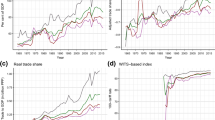Abstract
The crises in various emerging markets have affected Europe less than other parts of the world economy. This is largely because intra-regional relations dominate foreign trade and direct investment of EU countries. Yet, ongoing economic turbulences involve risks also for Europe.
Similar content being viewed by others
References
The Economist, October 17, 1998, p. 17.
E. Gundlach, P. Nunnenkamp: The European Union in the Era of Globalization. Competitive Challenges, Structural Unemployment, and Policy Responses, in: Konjunkturpolitik 40 (3/4), 1994, p. 202.
P. Nunnenkamp: Trade Relations between Europe and East Asia: A European Perspective, in: B.-S. Kim (ed.): Europe-East Asia Economic Relations: Current Status and Prospects, Korea institute for International Economic Policy, Seoul 1997, Table 4.
European Commission: The European Union as a World Trade Partner, European Economy, Reports and Studies 3, Luxemburg 1997, pp. 15 f.
(IMF: Direction of Trade Statistics, Washington, D. C.).
IMF: World Economic Outlook, Washington, D.C., September 1998, Table A5
The European Commission has reported similar results from a simulation analysis (Europäische Kommission: Wirtschaftsaussichten der EU für 1998–1999, Europäische Wirtschaft, Beiheft A, Wirtschaftsanalysen 3/4, Luxemburg 1998, p. 15).
OECD: International Direct Investment Statistics Yearbook, Paris 1997.
In the third quarter of 1998, operating income of Deutsche Bank was down to DM 70 million from DM 1.3 billion in the third quarter of 1997 (Handelsblatt, October 30, 1998).
Bank for International Settlements: Consolidated International Banking Statistics for End-1997, Press Release, Basle, May 25, 1998.
A. Boss, J. Döpke, E. Langfeldt, J. Scheide, R. Schmidt, H. Strauß: Aufschwung in Deutschland ohne Dynamik, in: Die Weltwirtschaft 4, 1997, p. 371.
The Economist, September 5, 1998, p. 19.
A. Boss et al.: Aufschwung in Deutschland ohne Dynamik, op. cit., in: Die Weltwirtschaft 4, 1997, p. 371. Stock market capitalization amounted to 40 per cent of GDP in Germany in 1997; the average figure for the EU (except the United Kingdom) was 51 per cent, compared with 166 per cent in the United Kingdom (Europäische Kommission, op. cit., Wirtschaftsaussichten der EU für 1998–1999, Europäische Wirtschaft, Beiheft A, Wirtschaftsanalysen 3/4, Luxemburg 1998, p. 16).
See A. Boss, J. Döpke, J. Gottschalk, E. Langfeldt, J. Scheide, R. Schmidt, H. Strauß: Trotz Belastungen: Aufschwung in Deutschland setzt sich fort, in: Die Weltwirtschaft 3, 1998, pp. 235–257, and The Economist, September 5, 1998.
J. Döpke, K.-J. Gern, J. Gottschalk, E. Langfeldt, J. Scheide, M. Schlie, H. Strauß: Euroland: New Conditions for Economic Policy, Kiel Discussion Papers 326, Institute of World Economics, Kiel 1998; E. Gundlach, P. Nunnenkamp. Labor Markets in the Global Economy: How to Prevent Rising Wage Gaps and Unemployment, Kiel Discussion Papers 305, Institute of World Economics, Kiel 1997.
The Economist, October 24, 1998, p. 107.
In contrast to the United States, the level and structure of wages have proven to be fairly rigid in continental Europe since the late 1970s; see: E. Gundlach, P. Nunnenkamp: The European Union in the Era of Globalization. Competitive Challenges, Structural Unemployment, and Policy Response, op. cit., in Konjunkturpolitik 40 (3/4), 1994, p. 202. E. Gundlach, P. Nunnenkamp: Labor Markets in the Global Economy: How to Prevent Rising Wage Gaps and Unemployment, op. cit..
D. Dohse, C. Krieger-Boden: Währungsunion und Arbeitsmarkt: Auftakt zu unabdingbaren Reformen, Kieler Studien 290, Mohr Siebeck, Tübingen 1998.
Ibid..
H. Siebert: Arbeitsproduktivität und Löhne in der Europäischen Währungsunion, in: Die Weltwirtschaft 2, 1998, pp. 115–120.
J. Döpke, K.-J. Gern, E. Langfeldt, J. Scheide, M. Schlie: Quo Vadis, Euroland?, Kiel Discussion Papers 313, Institute of World Economics, Kiel 1998.
J. Döpke et al.: Euroland: New Conditions for Economic Policy, op. cit., p. 14.
R. Dornbusch, C. Favero, F. Giavazzi: Immediate Challenges for the European Central Bank, in: Economic Policy 26, 1998, p. 52.
R. Ramaswamy, T. Sloek: The Real Effects of Monetary Policy in the European Union: What Are the Differences?, IMF Working Paper WP/97/160, International Monetary Fund, Washington, D.C. 1997.
Overnight rates (as of October 21, 1998) amounted to 3.4 per cent in France and Germany, compared with 4.9 per cent in the United States (The Economist, October 24, 1998, p. 141).
J. Döpke et al.: Quo Vadis, Euroland?, op. cit..
D. Begg, F. Giavazzi, C. Wyplosz: Options for the Future Exchange Rate Policy of the EMU, CEPR Occasional Paper, 17, Centre for Economic Policy Research, London 1997.
J. Döpke et al.: Euroland: New Conditions for Economic Policy, op. cit.,. p. 19 ff.
B. Eichengreen, C. Wyplosz: The Stability Pact: More than a Minor Nuisance?, in: Economic Policy 26, 1998, p. 71.
For example, Döpke et al.: Quo Vadis, Euroland?, op. cit..
R. Portes, H. Rey: The Emergence of the Euro as an International Currency, in: Economic Policy 26, 1998, pp. 305–343.
Döpke et al.: Euroland: New Conditions for Economic Policy, op. cit.,.
Author information
Authors and Affiliations
Additional information
The author appreciates comments suggestions by Rolf J. Langhammer and Joachim Scheide.
Rights and permissions
About this article
Cite this article
Nunnenkamp, P. Europe and the crisis. Intereconomics 34, 10–18 (1999). https://doi.org/10.1007/BF02928967
Issue Date:
DOI: https://doi.org/10.1007/BF02928967




